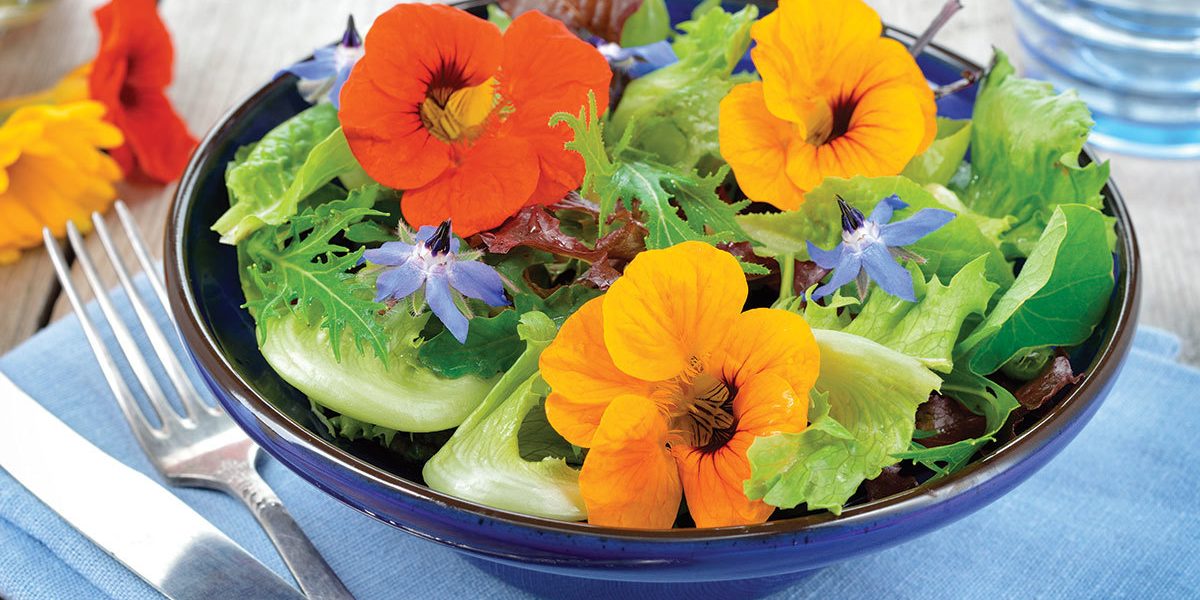Home & Living
Plant Platters
Dinner is served—in your garden, that is.
We wouldn’t blame you if you only associate a flower garden with beauty. But by introducing the right species, it can double as a tasty food source, too.
The uses for sliced and diced flower heads are just about endless, from adding flavor to sauces and dressings to providing ornamental touches on everything from salads to cakes and cocktails. And they’re nutritious, too—many flower buds are loaded with vitamin C or A. One caveat, though: They’re only safe to eat if they’re homegrown without chemical sprays, pesticides, or harsh fertilizers. With that in mind, here are six plants to get you started.
Daylilies
Tasting like asparagus, they come in many colors and produce a new lily bud each day. Buy bulbs in early spring after the last frost and plant in clusters in large containers using potting soil. Place the containers inside a garage or cool basement and water sparingly. When shoots begin to show, find a home for them that’s in sun or partial shade and plant them at least 8 inches deep in well-worked, organic-rich soil.
Apple blossoms
If you’re the proud owner of an apple tree, or perhaps have access to one in your neighborhood, then you’ve seen them burst into frothy red-pink fragrant blooms in the spring. The blossoms have a unique sweet-sour taste, like that of green apples, making them a nice addition for salads, desserts, and cocktails. And they’re more heat-tolerant than most flower varieties, making them a better choice for garnishing hot food.
Nasturtiums
Mid to late March is the ideal time to start your nasturtiums from seed. Plant them in pots indoors, in a sunny window, using potting soil, and water sparingly. By May, your seedlings will be ready to be planted outdoors in well-worked, average garden soil, as they’re known to produce fewer flowers in enriched soils. Pick a sunny spot that also provides some shade in the afternoon—nasturtiums don’t like to be fried. Flowers come in red, orange, and yellow, and are pungent to the taste, a bit like radishes.
Tuberous begonias
These charmers bloom in red, white, pink, yellow, and orange. They have a tart taste (and have been used for centuries to prevent scurvy, since they’re rich in Vitamin C). Plant in rich, slightly acidic potting soil, several inches deep in containers, and start them off indoors in a window out of direct sunlight. Keep the soil moist, but not too wet. Transplant outside after the last frost in organic-rich garden soil at least 8 inches deep, in a filtered sunlight setting.
Scented geraniums
Used for cooking, geraniums produce small pink, red, lavender, or yellow blossoms, and have a taste ranging from rose to lemon to nutmeg. They’re easily grown, thrive in the sun, and can be winterized indoors in a sunny window. They can be propagated from cuttings or started from seed, using the same process as nasturtiums.
Borage
This annual herb from Europe sports furry leaves and star-shape blue flowers that have a slight cucumber taste. Borage is easily started from seed and thrives in average soil with full sun, and it reseeds itself profusely.
Also on the menu: There are lots of other edibles, such as fennel, marigolds, redbud, roses, squash blossoms, and violets. A great resource to learn more about them is The Edible Flower Garden by Rosalind Creasy, which includes lots of photography of each variety, as well as recipes using flowers.
